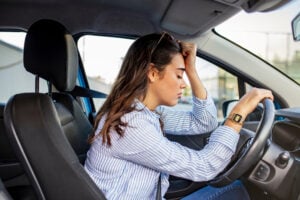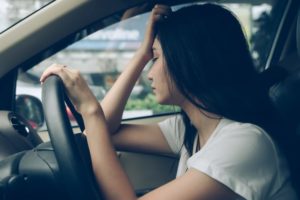How To Stay Awake on the Road
Drowsy driving is a major safety hazard in the U.S. In 2017 alone, the National High Traffic Safety Administration (NHTSA) estimates roughly 91,000 vehicle accidents – and nearly 800 fatalities – were attributed to crashes involving drowsy driving. For many drivers who cause these accidents, lack of sleep is a major factor.
While getting enough rest each night could potentially prevent some of these collisions, drivers should also educate themselves on the warning signs of drowsy driving and take measures to ensure they remain alert and cautious behind the wheel. These include abstaining from alcohol, pain-killers, or sleep-inducing medications if you plan to drive, and avoiding the road during times of the day when people are most vulnerable to drowsiness. In some cases, drowsy driving serves as a warning sign of an underlying sleep disorder.
What Causes Drowsiness While Driving?
Drowsy driving refers to any instance of operating a vehicle while fatigued or sleepy. Even if the driver has not consumed alcohol, studies have shown the effects of driving while sleep-deprived are similar to those of drunk driving. These effects include impaired attention and coordination, slower reaction time, and poor judgment. It’s believed that going 24 hours without sleep is comparable to having a blood-alcohol content of 0.10%, which exceeds the legal limit for driving in all 50 states.
Anyone can experience the effects of inadequate sleep, but certain individuals are more predisposed to drowsy driving. These include:
- Commercial drivers who operate tow trucks, semi-trucks, trailers, and other large vehicles.
- Shift workers who work at night or whose shifts are relatively long
- People with sleep disorders that cause sleep loss and/or sleep-disordered breathing
- Those who take medications that cause drowsiness
Additionally, certain driving environments pose a higher risk of drowsy driving-related accidents. Most of these collisions occur either in the late afternoon or between the hours of 12 am and 6 am. Both of these times coincide with natural energy dips controlled by your circadian clock, an internal timekeeping system that regulates sleep, appetite, and other bodily processes. Many drowsy drivers do not have passengers when their accidents occur, and a significant number of these crashes occur on rural roads and highways.
Warning signs to watch for if you’re concerned about drowsy driving include:
- Frequent yawning or blinking
- Feelings of “nodding off”
- Difficulty keeping your head upright
- Trouble remembering the last few miles you’ve driven
- Missing an exit or road sign
- Following other cars too closely
- Drifting into the other lane or hitting rumble strips
“Micro sleeps” are another dangerous effect of drowsy driving. These brief lapses into sleep typically last four to five seconds. At a speed of 55 miles per hour, a driver could potentially travel 100 yards before waking from their micro sleep.

What To Do if You Doze off While Driving
If you experience sudden sleepiness while driving or notice one of the other warning signs listed above, you should stop driving as quickly as possible. Pull into the next rest stop or any other safe, well-lit space that allows you to safely park and not obstruct the road. A 20-minute nap should leave you adequately refreshed and alert, but take more time if needed.
One thing to keep in mind is that coffee and other caffeinated beverages provide a temporary energy boost. After the effects of the caffeine have worn off, the feelings of drowsiness may return. A cup of coffee or two coupled with a brief roadside nap is recommended, but drinks to keep you awake while driving may not provide enough alertness on their own.
These measures should be seen as short-term interventions if you find yourself in a potentially dangerous situation. You can also reduce your risk of driving while drowsy by taking certain measures before you get behind the wheel.
Tip #1: Get Enough Sleep

Most adults between the ages of 18 and 64 should sleep at least seven hours a day . People older than 65 may not need as much sleep, but the recommended daily allotment is still a minimum of seven hours. People who don’t receive seven hours of daily sleep are at higher risk of being involved in a drowsy driving accident.
Teenagers of driving age need about eight to 10 hours of daily sleep. Many teens do not meet this benchmark and will feel more tired behind the wheel as a result. If you have a child who drives, stress the importance of adequate sleep and the dangers of getting behind the wheel when tired or drowsy.
Tip #2: Avoid Alcohol if You Plan To Drive

Drinking and driving obviously poses safety risks to you, your passengers, and other motorists on the road. That said, even legal amounts of alcohol for operating a vehicle can cause drowsiness behind the wheel. You should be especially careful if you already feel tired.
The same is true of prescription and over-the-counter medications, particularly anti-allergy pills, that induce feelings of sleepiness. Be sure to check the side effects of any new medications before driving. If these effects include drowsiness, consider using public transportation instead.
Tip #3: Time Your Drives Around Peak Sleepiness Periods

Avoid driving in the late afternoon or between the hours of 12 am and 6 am, when the highest number of drowsiness-related accidents occur. If this is not possible, then be as vigilant as possible while you’re on the road. Watch for warning signs that you’re feeling drowsy, such as drifting across lanes or hitting rumble strips, and keep an eye on other drivers for the same behaviors.

Tip #4 Improve Your Sleep Hygiene
Sleep hygiene refers to habits and practices that help ensure an adequate amount of high-quality sleep each night. Practicing good sleep hygiene can help you feel more alert and well-rested in the morning. Key aspects of proper sleep hygiene include:
- Consistent bedtimes: You should strive to go to sleep and wake up at the same time each day, including on the weekends and when you’re traveling.
- Optimize your sleep space: The best bedroom for high-quality sleep is dark and quiet. Room temperature is also important. Many experts agree that 65 degrees Fahrenheit (18.3 degrees Celsius) is the ideal sleep temperature for most people.
- Keep portable electronics out of the bedroom: Cell phones, computers and tablets, and televisions all emit blue light that can interfere with sleep. You may use a blue-light screen that may be built-in to your phone/tablet to reduce it. As an added precaution, do not use any of these devices within 30 minutes of bedtime.
- Avoid caffeine and alcohol before bed: Caffeine can disrupt your sleep, so it’s best to avoid caffeinated foods and drinks in the late afternoon or evening. Alcohol before bedtime can also cause sleep disruptions during the night. You may also want to avoid other fluids to cut down on nighttime trips to the bathroom.
- Don’t stew in bed: If you’ve been lying in bed for 20 minutes or longer and still don’t feel ready for sleep, consider getting up and relocating to another area of your residence. Wait until you feel tired before returning to bed, and avoid blue-light electronic devices while you wait.
- Practice healthy habits: Regular exercise during the day and a healthy diet can both improve your chances of a good night’s sleep.
- Talk to a doctor if problems arise: Sleep problems may indicate insomnia or other sleep disorders. If you notice recurring patterns of poor or insufficient sleep, make an appointment with your doctor to discuss your symptoms.

Still have questions? Ask our community!
Join our Sleep Care Community — a trusted hub of product specialists, sleep health professionals, and people just like you. Whether you’re searching for the perfect mattress or need expert sleep advice, we’ve got you covered. Get personalized guidance from the experts who know sleep best.
References
5 Sources
-
National High Traffic Safety Administration. (n.d.). Drowsy Driving.
https://www.nhtsa.gov/risky-driving/drowsy-driving -
National Center for Chronic Disease Prevention and Health Promotion, Division of Population Health. (2017, March 21). Drowsy driving. Centers for Disease Control and Prevention.
https://www.cdc.gov/sleep/about_sleep/drowsy_driving.html -
Governors Highway Safety Association. (n.d.). Alcohol Impaired Driving.
https://www.ghsa.org/state-laws/issues/alcohol%20impaired%20driving -
American Academy of Sleep Medicine. (2019, October 30). Too many Americans admit to driving while drowsy.
https://aasm.org/too-many-americans-admit-to-driving-while-drowsy/ -
Consensus Conference Panel, Watson, N. F., Badr, M. S., Belenky, G., Bliwise, D. L., Buxton, O. M., Buysse, D., Dinges, D. F., Gangwisch, J., Grandner, M. A., Kushida, C., Malhotra, R. K., Martin, J. L., Patel, S. R., Quan, S. F., Tasali, E., Non-Participating Observers, Twery, M., Croft, J. B., Maher, E., … Heald, J. L. (2015). Recommended amount of sleep for a healthy adult: A joint consensus statement of the American Academy of Sleep Medicine and Sleep Research Society. Journal of Clinical Sleep Medicine, 11(6), 591–592.
https://pubmed.ncbi.nlm.nih.gov/25979105/




